The holy grail of sound seems to be analog. Why? Because it holds more clarity? Hardly. Because it more accurately captures sound? Nope. Is it because your brain wants to hear all those pops, muddiness, and fizzles? Precisely. Effects are kinda the same. Though diligent programmers have been able to model digital delay and echo in every conceivable form with astronomically long delay times, there is still a demand for the old, limited use, barely functional analog delay effects for making music. Just look at eBay. The prices are high for what is ostensibly outdated technology. And what can I say, I’m one of those jerks who totally goes for it.
The DOD FX90 analog delay is not one of those delays one would call coveted, as it sells used for fairly cheap… why? I’m not sure. I like the delay sound on it. With some coaxing, it will run away and self-oscillate with the best of them. Likely, it’s not that coveted because there are many available. In the after-market for discontinued effects, if it’s rare, it must be AMAZING!
The actual circuit creates makes for a pleasing, warm and dark analog delay, but the construction of the pedal itself is sub-par. I scored a couple for cheap. That is to say, I found them left behind in our jam space and no one claimed them. They didn’t work, so I set out to get ’em going again.
[contextly_sidebar id=”aA4R0svYyDg4DSVaO6oNomWbQ7Pni7HS”]First, off, I’m not genius (yes I am). I got this pedal working again by re-soldering some loose 9V battery leads. They’d been jerked around because DOD never made a battery case cover that didn’t get lost. And how many pedals and electronics gear now exist in landfills because people wouldn’t look at this most obvious problem? Without electricity, you can’t have electronics. It’s fundamental, like Marvel being better than DC.
Once I got the pedal functioning again, I had to play with its guts a bit and learn a bit more about delays. Anything worth doing is worth overdoing.
Analog delay pedals use BBD (Bucket Brigade) IC chips that were invented by Philips in 1969 for a myriad of purposes, guitar effects pedals probably being last on the list. In fact, many of the chips were put it into televisions and public address systems not as an effect to be noticed, but to make things sound more natural.
They use a series of microscopic transistor-capacitor pairs that pass the signal out and to the next series pair, hence the name; the pairs act like an old-timey, fire-fighting bucket brigade with a signal in place of buckets. The transistors split the signal between the output and the capacitors that delay it before it gets to the next pair.
The capacitors in a BBD chip cut the high frequencies off each repetition and give analog delays their distinctly dark tone. It’s much the same way a capacitor on a tone knob cuts the highs coming out of a guitar, the way a capacitor can be added to darken a digital delay, or the way Keanu Reeves and Mark Wahlberg can dull an otherwise intelligent movie.
The DOD FX90 analog delay uses a Panasonic MN3005, long out of production. Strictly speaking, it isn’t “analog,” like tape delay. BBD IC chips are solid-state technology. Well, today’s “hardcore” doesn’t sound anything like Agnostic Front. You have to take the evolution of nomenclature with a grain of salt.
These solid-state IC delay chips were generally marketed for pedals as having a maximum 300 milliseconds of delay time. That’s a physical limit based on the number of transistors and capacitors that can be fit inside a single chip. This 300ms delay is more of recommendation, kinda like the speed limit on Interstate 5. They sound BEST when dialed in for no more than 300 milliseconds. Like most things designed to be used by musicians, the analog delay pedals were designed to be retard-proof. Each FX90 unit sold should sound the same. They are dialed in at 300ms, but that limit can be pushed a bit by playing with a trim pot inside. This is not recommended by anyone… except me.
By fiddling with the 1M Ohm delay trimpot, you can increase the delay time dramatically. Of course, your delay is going to start sounding wonky as fuck the further you push it. The delays will warble, bend, sometimes speed up a bit, sometimes slow down, and definitely sound like they come from a Nintendo 8 bit sound card.
If that’s what you’re looking for, you just found gold. Otherwise, keep the delay time within reason.
The other thing these chips are meant to do is provide a nice, decaying echo. C’mon, what’s the fun in that? Another adjustment on another trimpot and you can get it to self-oscillate: the point where the delay feeds back into itself. Turn the knob labeled “Repeat” all the way up, and then adjust the 2K2 Ohm feedback trimpot until the repeats don’t end, like episodes of Two and Half Men.
Once you have it adjusted to self-oscillate, the pedal can have the delays and repeats all the way up until the echoes start to race away. Adjust the delay slowly along with the mix knob, and you can get a sweet harmonic hum out of the pedal. It’s not super useful for a power metal band, I suppose, but great if you just wanna make some noise.
My FX90 self-oscillates to a perfect D note. Whether that’s because of my guitar or the chip, I know not. When I adjust the mix knob correctly, I can play over it as it drones. Not play well, but you get the point.
Once I got this pedal going, I really liked it. I wanted it on my pedal board. The last hurdle was the shitty DOD switching mechanism, which I’ve railed about before on other DOD pedals. Like BOSS pedals, DOD employs a jfet electronic switching mechanism. Unlike BOSS, DOD’s momentary switch is a piece of shit that breaks after some time. There’s also the conceit I have against buffered pedals, so it was time to mod this pedal for true-bypass.
The first hurdle with true-bypassing any pedal that uses an electronic switch is getting the effect to always be “on.” Usually this means reading a schematic and putting jumpers in place of of the transistors used for switching. Luckily, the FX90 effect is powered “on” as soon as the pedal is plugged in. Fuck the schematic, this bitch is ready to go. All that needs be done is wire up a 3PDT foot switch to the right connections and have at.Well, there also has to be space made inside this tiny pedal for a big 3PDT foot switch. One solution is to rehouse the entire pedal in a new enclosure. I wanted to keep the pedal in its original enclosure, though, so I had some very literal circuit bending to do.
Not having the original battery cover, I ditched the battery compartment entirely. Who wants to run a delay on batteries, anyway? They eat them up. I installed in its place a much tinier, and more standard, 2.1x5mm BOSS style barrel jack. This was wired in parallel with the original power jack. I installed it on a piece of sheet metal I glued into place. This is totally unnecessary if you want to use a 9V adapter with a 1/8″ plug.
Next, I actually bent the tines of the pots that connected to the circuit board. This had to be done carefully, lest I make any new contact points, or worse, just broke the tines. I could have cut the tines and soldered the pots in with leads. Then the circuit board would have been floating without anchor inside the enclosure. By bending the pots, I was able to still use them as spacers.
I bent all three until the circuit board rested towards the back of the enclosure. This almost made room enough for the switch. More daunting, I had to cut a piece of the circuit board out. I did have to trim back some of the contacts for a couple leads, but I left enough behind in order to still use them. Like I said, this was daunting.
Once the room was made, I threw away the original momentary switch. I pulled the other leads from the input jack and the circuit board and wired up the 3PDT foot switch as shown in the following diagram.
And the real thing just BARELY fits. It was important to add the ground lead to the middle poles in order to take the effect to ground when it was switched off. Initially I had skipped this step and got a nasty pop every time I engaged the effect. That’s why it’s attached to a ground on the opposite side of the circuit board… because I couldn’t be bothered to undo the whole thing once I found my mistake. Lazy!
Initially I just squeezed the 3PDT switch through a hole that was already in the enclosure to engage the original momentary switch. I had to trim the washer a bit, but I didn’t find this aesthetically pleasing.
Eventually, I drilled a hole through the old foot stomp plate and fit the new 3PDT switch through that. Now, this pedal rests comfortably on my board, ready to be splattered in blood as all my lovelies are.
So much work, and so little care. It’s just stuff to make noise, after all. Beautiful, analog noise.
For more info on the DOD FX90, visit the America’s Pedal site:
http://www.americaspedal.net/fx90/
An instruction manual is provided online by DOD:
ftp://ftp.dod.com/pub/PDFs/Discontinued/FX90.pdf

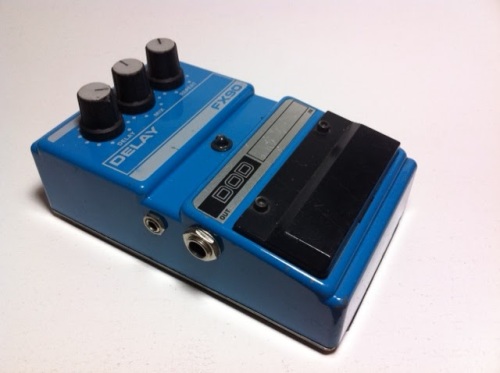
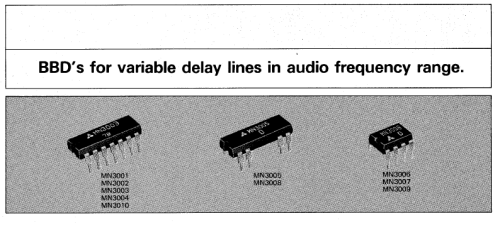
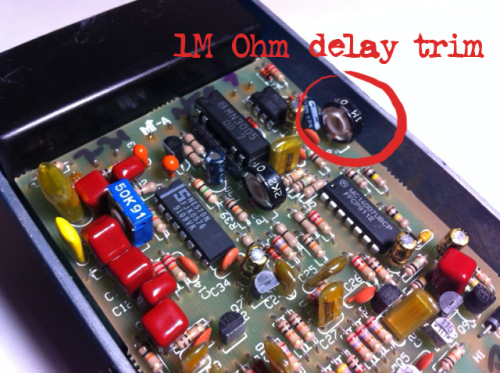
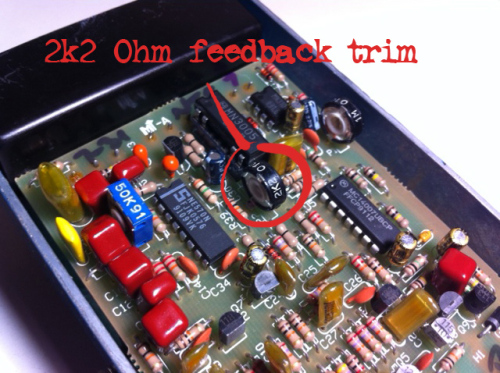
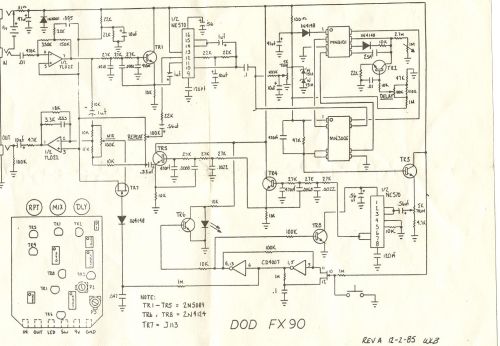
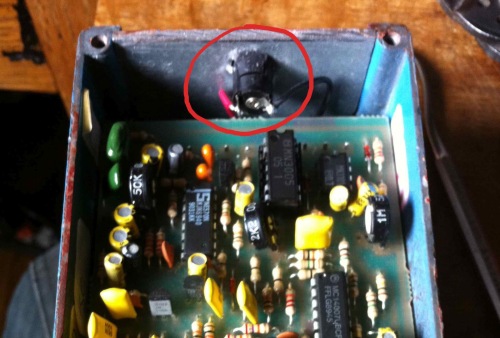
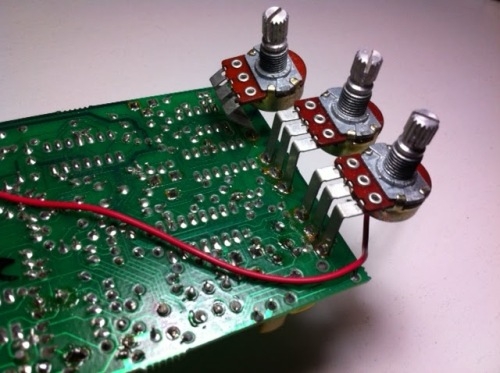
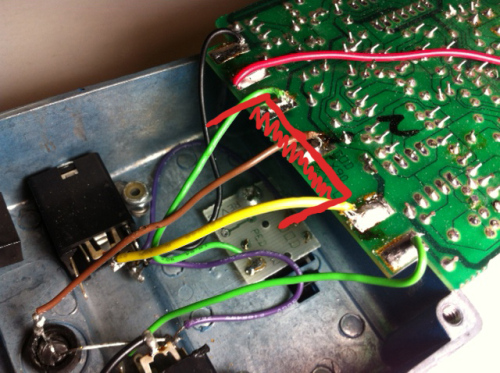
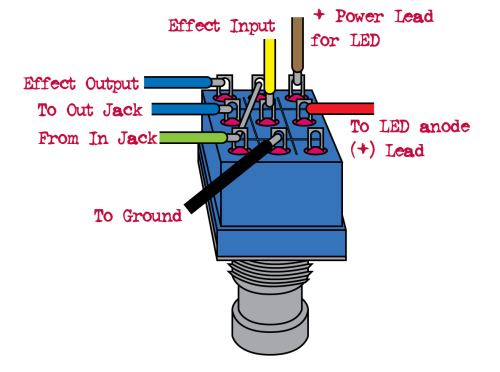
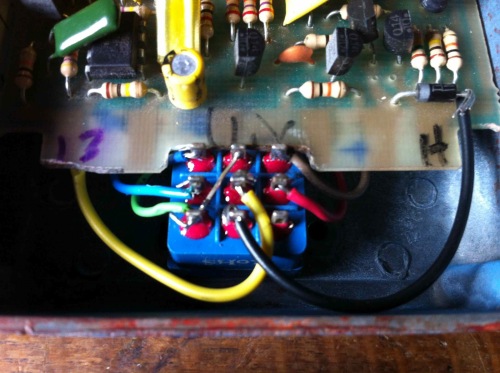
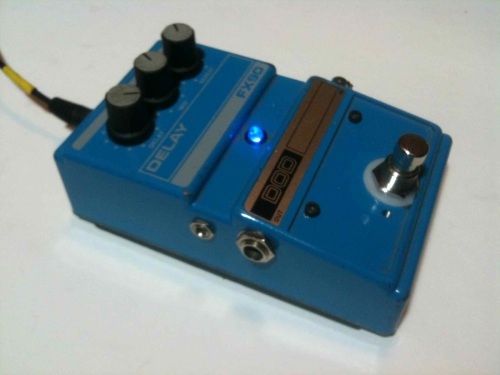
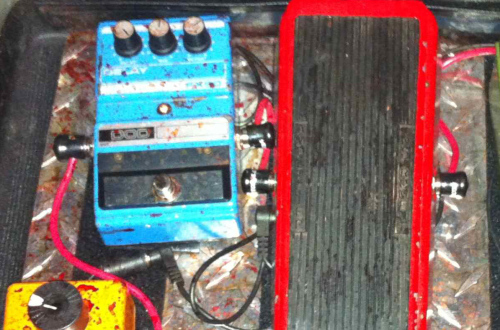
Thanks for such good info– I just picked up one of these and look forward to messing with it. Your true-bypass mod w/ footswitch looks like a good idea too. Thanks!
hi, just bought an FX90! I regulated the trimpots to get very long delay time and feedback, but self oscillation does not work like (according to your videos) it should… what am I doing wrong? also, what's the other trimpot (50k) for? thanks, Fabio
Hard to say why you can't get self-oscillation, not being there… You do need to crank the delay back up slowly and it's easy to kill it off by trying to get there too fast. Also, the repeat knob, when cranked up, needs to keep going, louder and louder, or the trimpot has not been regulated correctly for self-oscillation. Play with it some more, make sure you have the mix at least half way up if not more. The 50k trimpot is attached to a compander chip, which is basically an opamp and compressor. Messing with that probably won't do anything too exciting except making things sound bad.
[…] real estate be damned). It’s since been replaced on my board by an ACTUAL analog delay (a modded DOD FX90… more on that another time) but it did serve me […]
hey thanks for the rad tips! so i have myself a dod fx90 delay just like that one, and i read about yours here and so i gave it a try, being kinda handy or whatever.. but alas, i did something wrong. my question(s) to you: which contacts on the board (in your photos) are the input and output? where do you put the green wire from the old switch (from contact #3 from the left on the board)? also, in your photos there's a red lead coming from contact #2 … on mine here the lead is yellow, and it goes to the 9v power adaptor. i was curious because it looks like it goes to the repeat pot in your photo… what else…the brown + power lead that goes to the switch, is this the one from contact #4 on the board? thanks in advance for the help man.
So, you're wires might be differently colored than mine. And there could be a board revision, but likely your board is laid out the same.
When you're looking at the solder side of the board with the lead contacts at the bottom, the points from left to right are:
1. lead to electronic switch (not needed after true bypass)
2. +9V input from battery
3. lead to electronic switch (not needed after true bypass)
4. positive voltage for LED
5. signal output from board
6. signal input to board
The red wire is not connected to the feedback pot… I never realized, that was a really bad photo. I'm not sure why I draped the wire like that across the board!
hi – can you help me do the same with my fx33 buzz box??? i have followed your ideas here with no joy….. please help me?? i can forward any info you need……thanks
I guess you're looking to true-bypass it. Does the effect turn on when you put a cable into the input? If not, you'll have to modify the electronic switching on the circuit board. The means removing some transistors that are part of the electronic switching and bypassing them, but I can't say which because I can't find a schematic for this pedal online and don't have one of these myself. It is supposed to be a similar layout to the FX69 Grunge pedal, and there are instructions on how to true-bypass that here: http://www.diystompboxes.com/smfforum/index.php?topic=95442.0;prev_next=prev
I have a question I own one of the original FX 90 and the repeat goes crazy when you incrase it, keep going lounder none stop, I tried adjust both trims pot but still not work, can you help??? wooww seem your work here is amazine.
thanks
Open up the pedal. Turn the REPEAT knob on top of the pedal all the way up and trigger a sound into the pedal. When it runs away and gets louder that's called self-oscillation. The repeats feed into themselves. Most people want to be able to do that. If you want to decrease it, adjust the 2k2 trimpot (it's the middle one of the three trimpots). You should be able to turn it down so it doesn't self-oscillate. Very tiny turns of the knob make a big difference, so experiment until you get the delay time you're looking for.
Or, just keep the REPEAT knob turned down a bit to your taste.
hello guys, recently bought a dod FX90 on ebay with the wires connecting the circuit board desoldered, then searched on the internet for the scheme, but only found a previous model, .my fx90 has 10 transistors, so I decided to use this scheme, but still not working., since replacing. ci's: mn3005, sa570n, mc14007u. and only passes the clean audio without delay., my neurons will explode from trying to make my fx work again without success. Please, help me I will be most grateful. Thank you. Booneash.
That's really hard to say what could be wrong with so little info. But doing the shotgun approach might not be the best idea and a waste of your time. Have you done an audio probe? Follow the audio signal from the input into the delay circuit from part to part and see where it disappears… I keep meaning to write a tutorial on this myself, but in the meantime, follow this lead: http://www.diystompboxes.com/pedals/debug.html
Can you post a picture of where you wired the new input and output of the circuit? or do you not even have to bypass the switching system? Also they make low profile 3pdt switches that are a nice bit smaller. Bitcheslovemyswitches sells them for $3 and theyre actually a lot nicer and more durable than theyre standard 3pdts!
No, you don't have to bypass the switching system as the FX90 effect is switched on as soon as the pedal gets power. Thanks for the tip for bitcheslovemyswitches! I'll be checking out those low profile 3PDT.
This is so awesome. You are a great resource. I am mosding the bass compressor to be true bypass and going off of your instructions.
Can you briefly tell me what the top middle lug going to the bottom left lug does? I am not familiar with wiring or electronics but am trying to wrap my head around it.
Thanks!!
That's the path your signal will take to get to the effect circuit board (the yellow wire) when you engage the footswitch. Oppositely, if the effect is turned off, that will not be connected to the effect. Your signal will pass directly to the "out" jack through the switch.
Hello Doktor! 🙂
I just got my first FX90. It's an older version, but it's basically the same pedal, with the three trimpots etc.
There is something weird going on with the rate knob (which is labeled 'delay' in this pedal).
It's like it's inverted! (to go from fast to slow delays you have to turn anti-clockwise!)
Plus, the knob mostly works on the central part of the excursion of the pot…let's say between 10 o'clock and 2 o'clock. If you move the knob past that, almost nothing happens. It's not a big deal, because most of the rate range is still there on that "sweet spot", but it just feels weird when you play with it.
I tried adjusting the trimpots, but they didn't change this issue in any way.
I just would like to figure out the reason of this behaviour.
My FX90 does the same, and it’s an older model like yours. I’ve read about that behaviour on other webpages. Seems like it’s limited to the very first models.
I went and grabbed one after I seen that these have the MN3005, you cant go wrong at these prices. I’ll order the Low profile 3PDT switch instead. You changed a lot of caps, I did similar mod in a Boss Flanger and KMD stereo chorus, both with great sounding results. Do you have a cap list of what you changed? For the age of the pedal I will probably change the electro’s as well to audio grades
Anything I changed is listed in the article.
Great article! I’ve had the exact same delay for years and was disapointed when i got it that it doesnt self-oscilate. Im gonna have to crack it open now, I’ll probably wreck it but nevermind
Just opened mine up and a previous owner has actually left a note in there indicating what trim pot does what… That’s handy. It says: 50k = signal quality, 2k = delay time, 1meg = repeats
No way I’m not doing it now
Actually they got the 1meg and 2k mixed up on that note I see. Unfortunately I can’t cant get mine into infinite repeats for some reason. Even with the 2k trim all the way to the longest repeat setting : (
Make sure the repeat knob is at maximum on the outside, as well. It should work, but who knows… could be a different variable on the circuit from yours to mine. Parts tolerances could be playing a role here.
Love Digitech,DOD pedals etc! Bought a PDS1550 HOT , The circuit is pretty tweakable by the trims(4?) .1 trim a treble cut/boost to strong to not be as the front next mod time, then 2 trims(1M and 2k2) to the delay that you sent me light on with this niiiiice post, thank you. still a trim that I set with my FINGERS on the IC chips “too hot, go back. Don`t burn please situation” .misty pedal.
it’s fun to play with trims, but i highly recommend always marking the factory setting with some fingernail polish or paint pen in case you go too far and want to get it back easily!
Hi I don’t quite understand the wiring
I want to make my dod octopus true bypass
It’s on effect when Jack plugged in
Can you help me
i’m afraid i can’t help you more than the diagram already illustrates. you need to find the corresponding wires in your pedal (from input jack, to output jack, etc.) and solder them to the 3pdt as illustrated. the wire colors will be different in different pedals, so pay attention to where the wires are going from the circuit board and the pedal can be true-bypassed.
Hi I bought a FX90 modded true bypass. Is an older model.
1. Mine hasn´t the output jack grounded, I can see yours has a purple cable grounding both jacks but where does it goes next?
no, the picture you’re looking at is upside down… look at the orientation of the footswitch and flip it over. that’s the input jack with the ground wire. the purple wire is the signal input wire. the ground wire is only there connect the battery negative to ground when you plug in your cable to activate it.
Hi again. I have another question:
2. The pedal sometimes turns on when connected and sometimes not. When it doesnt, the switch doesnt turn it on neither, so i have to disconnect it from power and it works again. Suspect its the old switching system that is working here. It has the switch lead conected to the input jack(you say here its not needed) . Could this connection be the cause?
that sounds more like a loose connection somewhere. if the effect won’t turn on and clicking the footswitch does nothing, it’s not getting power. i would try the pedal with both battery and an ac adapter separately and try to replicate the failure both ways. if only one creates the failure, there’s probably a loose connection from that power source to the circuit board.
And again me:
3. I love the delay coulor but when activated it sucks away the bottom end of the dry signal of the guitar. Does this happen to yours also?
Thanks in advance! and thanks for posting this.
hmmm… this doesn’t seem correct. the dry signal should come through pretty clearly. i’m afraid that’s a little beyond my knowledge to diagnose from afar!
But all the youtube links are private?!
oh word… this is a very old post. it looks like youtube made all those old videos private because i had to update whether or not the videos were “primarily made for children” as according to the recently enacted Children’s Online Privacy Protection Act (COPPA). They videos are available again. Thanks for bringing this to my attention
Good article, thank you! I picked one of these up and it sounds lush and gorgeous… except that the repeats knob has zero effect; I tested the potentiometer and it seems to be functional… I fiddled with the various trim pots but still didn’t have an impact on the number of repeats. Which is fixed to about one repeat… Any thoughts would be welcome!
Thanks for this! A friend just handed off his FX90 for me to fix, and as soon as I opened it and saw an extra capacitor soldered to the “wrong” side of the board, I felt that familiar feeling of “Oh F%#$, someone has beed messing around in here already. Who knows what they messed up.” This article will come in very handy.